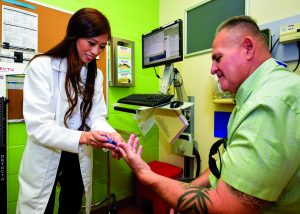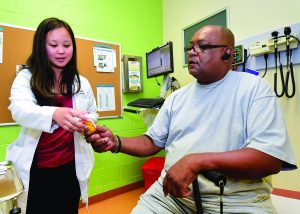In 2012, the Centers for Medicare and Medicaid Services (CMS) awarded researchers at USC Mann a $12 million grant—the largest ever at the School—to improve healthcare outcomes, reduce avoidable hospitalizations and emergency visits, enhance medication adherence and safety, and lower overall costs for high-risk, underserved populations. USC partnered with AltaMed Health Services to embed pharmacy teams in six safety-net clinics in communities with populations vulnerable to health disparities and with limited access to care.
The study “is designed to address both the widespread misuse of prescribed medications and the shortage of primary care providers in low-income populations,” says Geoffrey Joyce, principal investigator on the grant and an associate professor at the school.
According to Steven Chen—the Hygeia Centennial Chair in Clinical Pharmacy, chair of the Titus Family Department of Clinical Pharmacy and Pharmaceutical Economics & Policy, and co-investigator overseeing the effort’s clinical aspects—the project is expected to lower overall healthcare costs for patients served, not to mention the enormous benefit to individual patients in terms of better health quality, safety and satisfaction. “It will serve as a model not only for other safety-net clinics, but also for all healthcare settings in the U.S. since medication misuse is not limited to the underserved,” he adds.
The New Team Gains Acceptance
 “A Day in the Life” explores how a pharmacy team interacts with one another and with patients, during a day at the AltaMed safety-net clinic in Pico Rivera. Headed by clinical pharmacist Lily Yip, PharmD ’11, and including pharmacy resident Connie Chu, pharmacy care manager Melanie Sarabia and medical assistant Fanny Sanchez, the team sees patients with chronic conditions such as diabetes, hypertension, high cholesterol, asthma and heart failure, as well as those on blood thinners. About 60 percent to 70 percent suffer from diabetes, and many have multiple conditions.
“A Day in the Life” explores how a pharmacy team interacts with one another and with patients, during a day at the AltaMed safety-net clinic in Pico Rivera. Headed by clinical pharmacist Lily Yip, PharmD ’11, and including pharmacy resident Connie Chu, pharmacy care manager Melanie Sarabia and medical assistant Fanny Sanchez, the team sees patients with chronic conditions such as diabetes, hypertension, high cholesterol, asthma and heart failure, as well as those on blood thinners. About 60 percent to 70 percent suffer from diabetes, and many have multiple conditions.
At first, some physicians at the clinic were skeptical of partnering with a pharmacist, recalls Yip, who has been there since the project’s inception. “After a month or two, the volume really picked up,” she says, attributing the rapid growth in physician referrals to positive patient feedback and health outcomes. “We’ve come a long way.” Today the team sees an average of 15 patients a day and approximately 300 a month.
Keith Somsanith, DO, who practices family medicine at the clinic, needed no convincing of the value of a pharmacist on the healthcare team. “I trained with clinical pharmacists—going on rounds with them—during my residency,” he says. “Having them on the team provides great care.”
Having the pharmacy team has really increased access to care for our patients. Those who need followup care can get it more quickly as we can leapfrog between physician visits and pharmacist visits. This ultimately brings the patient into better disease control. Two heads are better than one.
Keith Somsanith, DO
The pharmacy team has a great deal of autonomy to adjust patients’ medications and initiate therapy when patient results fall outside guidelines, says Chu. “Most of the time, the patients we see here are not strictly following physicians’ plans,” she says. “You have to deal with other issues patients face, like social issues and making sure they have access to a medication in the first place. Sometimes you come in with a huge plan in mind and all these goals for the patient, but you have to target the most important first and take everything one step at a time.”
Emily McGee attributes the pharmacy team’s care with getting her blood sugar under control, as well as providing much-needed moral support. “They’ve done wonders for me,” she says. A year and a half ago, McGee struggled to get her blood sugar below a dangerously high 400. Today, her levels are in the 90s.
“The pharmacy team changed my perspective on how I see food,” she says. “They’ve helped me empower myself. Together we’ve taken a proactive course at getting my numbers down and getting my life back. They are the backbone of my support system.”
 Gilbert Melendrez tells a similar story. He developed diabetes 15 years ago but didn’t have insurance or access to medical care. A year ago, when he started working with the pharmacy team at the AltaMed clinic, his blood sugar was at 476. Now it’s routinely in the 90s. “I watched my father die of kidney failure due to complications from diabetes,” he says. “I was blessed to get into this program and blessed with a good pharmacy team. They treat you as a person.”
Gilbert Melendrez tells a similar story. He developed diabetes 15 years ago but didn’t have insurance or access to medical care. A year ago, when he started working with the pharmacy team at the AltaMed clinic, his blood sugar was at 476. Now it’s routinely in the 90s. “I watched my father die of kidney failure due to complications from diabetes,” he says. “I was blessed to get into this program and blessed with a good pharmacy team. They treat you as a person.”
A vocational pastor frequently on the go, he adds that the team works with him to find an approach to healthy eating and medication adherence that works for his unique needs and hectic schedule. Before he leaves the appointment, Sarabia—a pharmacy technician—sets him up with a nutritionist appointment to coincide with his next visit.
Sarabia, who joined the team in November 2012, provides a wide array of patient assistance—from support with insurance questions to following up with patients who miss an appointment and from helping ensure they don’t run out of refills to collecting data for the grant. She also coordinates other needed care, such as referrals for podiatry, cardiology and ophthalmology services. The group expanded again in August 2013 with the addition of medical assistant Sanchez, who takes patient vital signs, tests blood sugar levels and collects full medical histories to allow the pharmacists more one-on-one time with the patients.
Little Steps Lead to Big Results
 On the day we visited the clinic, Yip spent an hour with new patient Steven Williams, reviewing every medication and the optimal timing and method for taking each. She gave him a log sheet and explained how to use it for tracking his sugar levels. She listened sympathetically as he shared concerns about insurance coverage, and asked about his next dental appointment when he complained about his loose teeth and how hard they make it to follow a healthy diet. She offered free smoking-cessation patches for when he is ready to give up the habit. And she asked if he is checking his feet daily for cuts, and when his next appointment with the podiatrist is scheduled.
On the day we visited the clinic, Yip spent an hour with new patient Steven Williams, reviewing every medication and the optimal timing and method for taking each. She gave him a log sheet and explained how to use it for tracking his sugar levels. She listened sympathetically as he shared concerns about insurance coverage, and asked about his next dental appointment when he complained about his loose teeth and how hard they make it to follow a healthy diet. She offered free smoking-cessation patches for when he is ready to give up the habit. And she asked if he is checking his feet daily for cuts, and when his next appointment with the podiatrist is scheduled.
Phyllis Antolick remembers when she first began working with the pharmacy team almost two years ago. “They helped me understand blood sugar, and worked with me on exercise and what to look for on food labels,” she says. Working with the team, Antolick—who hates needles—says she was able to go off of insulin over a year ago.
For patients with complicated issues, visits might be weekly until they become stable. “You make little steps at a time, and then once they see the results and they start feeling better, that’s when they really start listening and doing more,” Yip says.
“They soon realize that we listen and we provide advice based on their needs and wants, and they appreciate that,” she says. “That’s why they keep coming back.”

